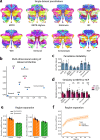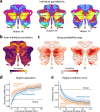A hierarchical atlas of the human cerebellum for functional precision mapping
- PMID: 39333089
- PMCID: PMC11436828
- DOI: 10.1038/s41467-024-52371-w
A hierarchical atlas of the human cerebellum for functional precision mapping
Abstract
The human cerebellum is activated by a wide variety of cognitive and motor tasks. Previous functional atlases have relied on single task-based or resting-state fMRI datasets. Here, we present a functional atlas that integrates information from seven large-scale datasets, outperforming existing group atlases. The atlas has three further advantages. First, the atlas allows for precision mapping in individuals: the integration of the probabilistic group atlas with an individual localizer scan results in a marked improvement in prediction of individual boundaries. Second, we provide both asymmetric and symmetric versions of the atlas. The symmetric version, which is obtained by constraining the boundaries to be the same across hemispheres, is especially useful in studying functional lateralization. Finally, the regions are hierarchically organized across three levels, allowing analyses at the appropriate level of granularity. Overall, the present atlas is an important resource for the study of the interdigitated functional organization of the human cerebellum in health and disease.
© 2024. The Author(s).
Conflict of interest statement
The authors declare no competing interests.
Figures





Update of
-
A hierarchical atlas of the human cerebellum for functional precision mapping.bioRxiv [Preprint]. 2024 Jun 1:2023.09.14.557689. doi: 10.1101/2023.09.14.557689. bioRxiv. 2024. Update in: Nat Commun. 2024 Sep 27;15(1):8376. doi: 10.1038/s41467-024-52371-w. PMID: 38260680 Free PMC article. Updated. Preprint.
References
-
- Strick, P. L., Dum, R. P. & Fiez, J. A. Cerebellum and nonmotor function. Annu. Rev. Neurosci.32, 413–434 (2009). - PubMed
-
- Schmahmann, J. D. Disorders of the cerebellum: Ataxia, dysmetria of thought, and the cerebellar cognitive affective syndrome. J. Nurse Pract.16, 367–378 (2004). - PubMed
-
- Schmahmann, J. D. et al. Three-dimensional MRI atlas of the human cerebellum in proportional stereotaxic space. Neuroimage10, 233–260 (1999). - PubMed
-
- Diedrichsen, J., Balsters, J. H. H., Flavell, J., Cussans, E. & Ramnani, N. A probabilistic MR atlas of the human cerebellum. Neuroimage46, 39–46 (2009). - PubMed
Publication types
MeSH terms
Grants and funding
- R01 MH124004/MH/NIMH NIH HHS/United States
- PJT-507612/Gouvernement du Canada | Instituts de Recherche en Santé du Canada | CIHR Skin Research Training Centre (Skin Research Training Centre)
- RGPIN-2016-04890/Gouvernement du Canada | Natural Sciences and Engineering Research Council of Canada (Conseil de Recherches en Sciences Naturelles et en Génie du Canada)
LinkOut - more resources
Full Text Sources
Medical

